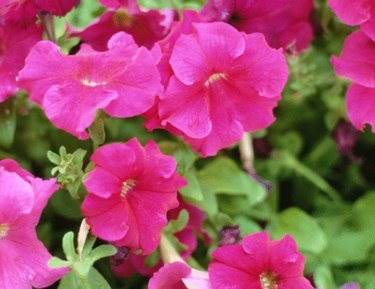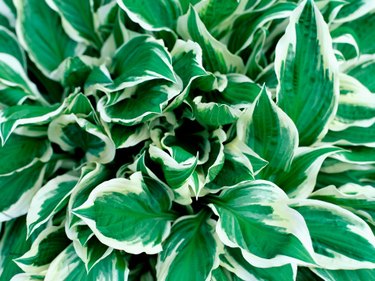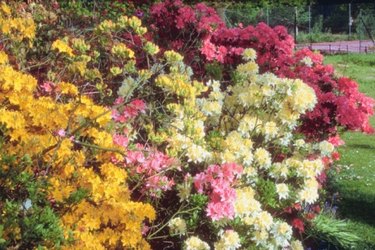With more than 50 species of coral bells (Heuchera) available in various shapes, sizes and colors, there is sure to be one to go with all of your favorite plants. There are varieties that do well in full sun, part sun or full shade. The foliage colors include black, lime green, peach, purple and amber. In late spring, dainty bell-shaped flowers emerge on thin, wire-like stems.
Annuals
Video of the Day

Impatiens, begonia, torenia, petunia and verbena all look good when grown alongside coral bells. Impatiens are ideal companions in the shade garden or even in containers. They flower nonstop all summer. The flowers come in a wide range of colors including purple, red, pink and white. Wax begonias have white or pink flowers with either green or chocolate-colored foliage. When pairing this annual plant with coral bells, consider the foliage colors of both plants and choose color combinations that complement one another. Torenia does best in partial shade and produces pink or purple and white wishbone-shaped flowers. This plant will flower all summer. Petunia and verbena grow best in full sun. Both plants will flower throughout the summer and come in numerous colors.
Video of the Day
Bulbs

Crocus, snowdrops, daylilies and iris are just a few of the numerous bulbs that combine well with coral bells. Plant the bulbs at the same time as the coral bells if possible. This will enable you to get the bulbs closer to the coral bells without damaging or disturbing their root system. Crocus and snowdrops are some of the earliest flowering bulbs, sometimes producing flowers before the snow melts. Since coral bells are evergreen, this combination can have a major impact on the early season garden. Iris bloom in late spring and will thrive in full or part sun. Plant them behind the coral bells since they are taller. Daylilies are another plant that will thrive in full or part sun. Their foliage looks similar to a green waterfall creating interest and adding texture when paired with coral bells. Daylilies come in many sizes from miniatures to varieties with flowers more than 5 feet tall. The flowers come in almost every color of the rainbow except blue.
Perennials

Coral bell is a perennial plant that looks good when grown in combination with hosta, painted fern, sweet woodruff, silver Artemisia, columbine, astilbe, pulmonaria or Solomon's seal. When selecting perennials to pair coral bells with, consider the foliage colors, textures and mature sizes of the plants. Consider too the preferred growing conditions of the perennials. Pair plants that prefer to grow under the same light, soil and moisture conditions. Perennials that are too large will overpower them. Coral bell is an ideal plant to use as an edging plant in the perennial flowerbed. Perennials with variegated foliage look especially stunning when paired with coral bells that have dark foliage.
Shrubs

Plant coral bells under, or close to, euonymus, daphne, ninebark and azalea. Coral bells grown under shrubs help block weeds and keep the shrubs' roots cool. The shrubs provide shade for the coral bells. Consider flower color and bloom time when selecting shrubs for coral bell companions. Another important consideration when pairing coral bells with shrubs is quality of the soil. Amend the soil before planting with organic matter to make sure both plants have adequate nutrients available to them. Consider setting up an automatic watering system or make sure you have the time to water since coral bells prefer moist soil.